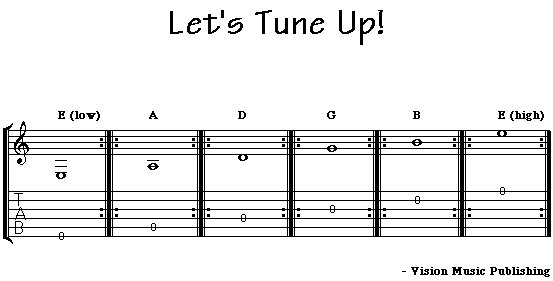
|
Tuning Your Guitar: Listen carefully to the provided audio track and tune your guitar, beginning with your low E (6th string), then A (5th string), D (4th string), G (3rd string), B (2nd string), and finally your high E (1st string).
#1: Buy A Tuner! Nowadays no guitarist in their right mind doesn't own an electronic tuner, for a number of reasons: 1) It's convenient. Why waste time tuning totally by ear when you can be playing instead? 2) Ear improvement. Using a tuner will "train" your ear to hear the guitar in perfect tune! 3) Even if you do tune by ear, you need an accurate "reference" pitch (piano, tuning fork). Tuner Recommendation: There are many decent models on the market, but I prefer the Sabine. #2: Learn "Basic" Tuning Despite the advantage in using an electronic tuner, every guitarist should know "basic 5th-fret" tuning: 1) Play an A on the low E (6th) string at the 5th fret. Match your open A (5th) string to it. 2) Play a D on the A (5th) string at the 5th fret. Match your open D (4th) string to it. 3) Play a G on the D (4th) string at the 5th fret. Match your open G (3rd) string to it. 4) Play a B on the G (3rd) string at the 4th fret. Match your open B (2nd) string to it. 5) Play an E on the B (2nd) string at the 5th fret. Match your open high E (1st) string to it. Note: As mentioned above, you'll still need a "reference" pitch (piano, tuning fork) prior to basic tuning to really be in tune, and if you make even a tiny mistake in matching that pitch you'll be out of perfect tune. Conclusion? Buy a tuner! #3: Tuning with "Harmonics" A second option to "basic" tuning is tuning with "harmonics" generated at the 5th and 7th frets. Natural harmonics are "bell-like" tones created by lightly depressing a string directly over the fret wire, then plucking or flatpicking with the right-hand. The strongest frets for natural harmonics are the 12th, 5th, and 7th. Procedure for "harmonic" tuning: 1) Play an E harmonic on the low E (6th) string at the 5th fret. Match it with the E harmonic on the open A (5th) string at the 7th fret. 2) Play an A harmonic on the A (5th) string at the 5th fret. Match it with the A harmonic on the open D (4th) string at the 7th fret. 3) Play a D harmonic on the D (4th) string at the 5th fret. Match it with the D harmonic on the open G (3rd) string at the 7th fret. 4) Play a B harmonic on the low E (6th) string at the 7th fret. Match it with the B harmonic (one octave higher) on the open B (2nd) string at the 12th fret. 5) Play an E harmonic on the A (5th) string at the 7th fret. Match it with the E harmonic (one octave higher) on the open E (1st) string at the 12th fret. Note: Despite the fact that harmonics can make it easier to hear the "wave" of a pitch, this form of tuning is generally not considered to be as accurate as the "basic" method. And, as mentioned above, you'll still need a "reference" pitch (piano, tuning fork) prior to harmonic tuning to really be in tune. Conclusion? Buy a tuner! |
For the "ultimate" guitar experience...